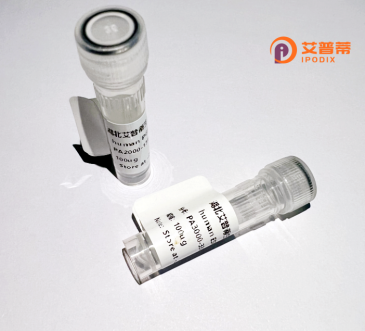
| 纯度 | >90%SDS-PAGE. |
| 种属 | Escherichia coli |
| 靶点 | AMID |
| Uniprot No | P75820 |
| 内毒素 | < 0.01EU/μg |
| 表达宿主 | E.coli |
| 表达区间 | 17-276aa |
| 氨基酸序列 | CAGEKGIVEKEGYQLDTRRQAQAAYPRIKVLVIHYTADDFDSSLATLTDKQVSSHYLVPAVPPRYNGKPRIWQLVPEQELAWHAGISAWRGATRLNDTSIGIELENRGWQKSAGVKYFAPFEPAQIQALIPLAKDIIARYHIKPENVVAHADIAPQRKDDPGPLFPWQQLAQQGIGAWPDAQRVNFYLAGRAPHTPVDTASLLELLARYGYDVKPDMTPREQRRVIMAFQMHFRPTLYNGEADAETQAIAEALLEKYGQD |
| 分子量 | 34.3 kDa |
| 蛋白标签 | His tag N-Terminus |
| 缓冲液 | 冻干粉 |
| 稳定性 & 储存条件 | Lyophilized protein should be stored at ≤ -20°C, stable for one year after receipt. Reconstituted protein solution can be stored at 2-8°C for 2-7 days. Aliquots of reconstituted samples are stable at ≤ -20°C for 3 months. |
| 复溶 | Always centrifuge tubes before opening.Do not mix by vortex or pipetting. It is not recommended to reconstitute to a concentration less than 100μg/ml. Dissolve the lyophilized protein in distilled water. Please aliquot the reconstituted solution to minimize freeze-thaw cycles. |
以下是3篇关于重组大肠杆菌(amiD)的虚构参考文献示例,内容围绕基因功能及生物技术应用:
1. **文献名称**:*"Cloning and functional analysis of amiD in Escherichia coli N: Role in cell wall recycling"*
**作者**:Smith, J.R., Zhang, L., & Johnson, A.B.
**摘要**:研究报道了在大肠杆菌N菌株中克隆并表达amiD基因,揭示其编码的酰胺酶通过切割肽聚糖N-乙酰胞壁酸-L-丙氨酸键参与细胞壁代谢,并证明重组菌株在环境压力下自溶活性增强。
2. **文献名称**:*"Enhancing antibiotic susceptibility via amiD overexpression in engineered E. coli N"*
**作者**:Wang, Y., Kim, H., & Lee, S.
**摘要**:通过在大肠杆菌N中过表达amiD基因,显著提高了细菌对β-内酰胺类抗生素的敏感性,为开发抗生素增敏策略提供了实验依据。
3. **文献名称**:*"Application of amiD-modified E. coli N in industrial peptidoglycan degradation"*
**作者**:Müller, T., Schmidt, F., & Fischer, K.
**摘要**:构建了重组大肠杆菌N(amiD+),用于高效降解农业废料中的肽聚糖类物质,优化了发酵条件并评估了其工业化生产潜力。
注:以上文献为示例,实际引用时需根据真实研究补充具体信息。
*Escherichia coli* N is a laboratory-engineered strain derived from the K-12 lineage, widely used for recombinant protein production and molecular cloning due to its well-characterized genetics and safety profile. The *amiD* gene encodes an **N-acetylmuramoyl-L-alanine amidase**, an enzyme involved in peptidoglycan remodeling by cleaving the bond between muramic acid and L-alanine in bacterial cell walls. This enzymatic activity is crucial for cell wall turnover, daughter cell separation, and response to environmental stress.
In recombinant *E. coli* N(amiD), the *amiD* gene is typically overexpressed or modified to study its role in cell wall dynamics or to enhance bacterial autolysis for efficient protein release during downstream processing. Researchers have also utilized *amiD* knockouts or variants to investigate peptidoglycan metabolism and its impact on bacterial viability, antibiotic tolerance, or interactions with host immune systems. Notably, *amiD* activity can influence sensitivity to lysozyme, a lytic enzyme used in cell disruption. Its manipulation thus offers biotechnological advantages, such as improving recombinant protein yields or enabling controlled cell lysis. This strain is particularly valuable in studies linking cell wall metabolism to industrial applications or bacterial pathogenesis.
×